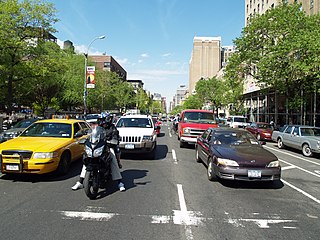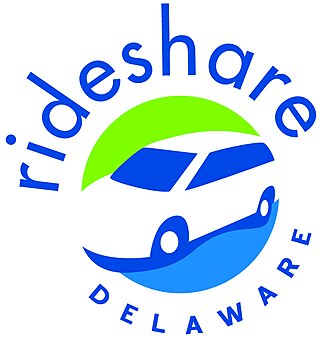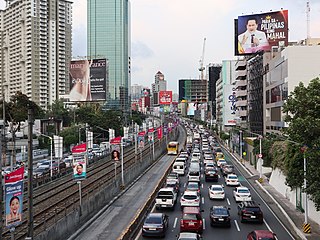
The term remote work became popular during the COVID-19 pandemic that forced the majority of office and knowledge workers to work from home. Prior to that, the practice of working full days from home or somewhere nearer to home than the office, was largely known as telecommuting.

Traffic congestion is a condition in transport that is characterized by slower speeds, longer trip times, and increased vehicular queueing. Traffic congestion on urban road networks has increased substantially since the 1950s. When traffic demand is great enough that the interaction between vehicles slows the speed of the traffic stream, this results in some congestion. While congestion is a possibility for any mode of transportation, this article will focus on automobile congestion on public roads.

Commuting is periodically recurring travel between one's place of residence and place of work or study, where the traveler, referred to as a commuter, leaves the boundary of their home community. By extension, it can sometimes be any regular or often repeated travel between locations, even when not work-related. The modes of travel, time taken and distance traveled in commuting varies widely across the globe. Most people in least-developed countries continue to walk to work. The cheapest method of commuting after walking is usually by bicycle, so this is common in low-income countries, but is also increasingly practised by people in wealthier countries for environmental and health reasons. In middle-income countries, motorcycle commuting is very common. The next technology adopted as countries develop is more dependent on location: in more populous, older cities, especially in Eurasia mass transit predominates, while in smaller, younger cities, and large parts of North America and Australasia, commuting by personal automobile is more common. A small number of very wealthy people, and those working in remote locations around the world, also commute by air travel, often for a week or more at a time rather than the more typical daily commute. Transportation links that enable commuting also impact the physical layout of cities and regions, allowing a distinction to arise between mostly-residential suburbs and the more economically focused urban core of a city, but the specifics of how that distinction is realized remain drastically different between societies, with Eurasian "suburbs" often being more densely populated than North American "urban cores".

Sustainable transport refers to ways of transportation that are sustainable in terms of their social and environmental impacts. Components for evaluating sustainability include the particular vehicles used for road, water or air transport; the source of energy; and the infrastructure used to accommodate the transport. Transport operations and logistics as well as transit-oriented development are also involved in evaluation. Transportation sustainability is largely being measured by transportation system effectiveness and efficiency as well as the environmental and climate impacts of the system. Transport systems have significant impacts on the environment, accounting for between 20% and 25% of world energy consumption and carbon dioxide emissions. The majority of the emissions, almost 97%, came from direct burning of fossil fuels. In 2019, about 95% of the fuel came from fossil sources. The main source of greenhouse gas emissions in the European Union is transportation. In 2019 it contributes to about 31% of global emissions and 24% of emissions in the EU. In addition, up to the COVID-19 pandemic, emissions have only increased in this one sector. Greenhouse gas emissions from transport are increasing at a faster rate than any other energy using sector. Road transport is also a major contributor to local air pollution and smog.

Transportation demand management, traffic demand management or travel demand management (TDM) is the application of strategies and policies to reduce travel demand, or to redistribute this demand in space or in time.
The Lexington Area Metropolitan Planning Organization (MPO) has been involved with transportation planning in Lexington, Kentucky, USA, and its immediate area since being established in 1974. It is responsible, in cooperation with the Kentucky Transportation Cabinet, for planning and coordinating all aspects of transportation planning on behalf of local governments within its region, which includes the Lexington-Fayette Urban County Government and Jessamine County.

The Denver Regional Council of Governments is a nonprofit, membership organization of local governments in the Denver region of the state of Colorado. DRCOG is the designated metropolitan planning organization (MPO) and the Transportation Planning Region (TPR) for the region, as well as the Area Agency on Aging (AAA).

The United States produced 5.2 billion metric tons of carbon dioxide equivalent greenhouse gas (GHG) emissions in 2020, the second largest in the world after greenhouse gas emissions by China and among the countries with the highest greenhouse gas emissions per person. In 2019 China is estimated to have emitted 27% of world GHG, followed by the United States with 11%, then India with 6.6%. In total the United States has emitted a quarter of world GHG, more than any other country. Annual emissions are over 15 tons per person and, amongst the top eight emitters, is the highest country by greenhouse gas emissions per person. However, the IEA estimates that the richest decile in the US emits over 55 tonnes of CO2 per capita each year. Because coal-fired power stations are gradually shutting down, in the 2010s emissions from electricity generation fell to second place behind transportation which is now the largest single source. In 2020, 27% of the GHG emissions of the United States were from transportation, 25% from electricity, 24% from industry, 13% from commercial and residential buildings and 11% from agriculture. In 2021, the electric power sector was the second largest source of U.S. greenhouse gas emissions, accounting for 25% of the U.S. total. These greenhouse gas emissions are contributing to climate change in the United States, as well as worldwide.

In New York City, a planned congestion pricing scheme will charge vehicles traveling into or within the central business district of Manhattan. First proposed in 2007, this disincentivizing fee to cut down on traffic congestion was approved and included in the 2019 New York State budget.
The H-GAC 2035 Regional Transportation Plan is the long range transportation plan for the Houston-Galveston Area and serves as blueprint for further planning to be undertaken in the region over the next 30 years. The plan which was developed in a joint cooperation with Cities, Counties, Texas Department of Transportation (TxDOT) and METRO. The RTP combines research, plans and programs by various organizations into one comprehensive plan which is updated every four years. The RTP's main aim is to identify long-range transportation needs, prioritize programs and projects and to provide a forum for dialogue and regional problem solving.
An employer in the United States may provide transportation benefits to their employees that are tax free up to a certain limit. Under the U.S. Internal Revenue Code section 132(a), the qualified transportation benefits are one of the eight types of statutory employee benefits that are excluded from gross income in calculating federal income tax. The qualified transportation benefits are transit passes, vanpooling, bicycling, and parking associated with these things.
CommuteSmart is a program of the Regional Planning Commission of Greater Birmingham, Alabama, which works with employers and commuters to reduce traffic congestion and improve air quality in Jefferson and Shelby Counties.
The Cumberland Community Improvement District (CID) is a self-taxing district covering 6.5 square miles (17 km2) in southern Cobb County, Georgia, that includes the intersections of I-75, I-285 and U.S. Highway 41. The Cumberland CID, Georgia’s first CID, was formed by business leaders interested in improving access to the highways for Atlanta’s emerging northwest market, known as Cumberland.
Green Action Centre (GAC) (formally known as the Recycling Council of Manitoba and the Resource Conservation Manitoba) is an environment non-profit organization based in Manitoba, Canada. It includes promoting greener living through environmental education for households, workplaces, schools, and communities. It also develops and advocates environmental policies for the Manitoba communities. Its primary areas of activity include; green commuting, composting and waste, sustainable living, and resource conservation.

RideShare Delaware is DART First State's program to reduce traffic and encourage alternative transportation arrangements. The program is supported by state and federal funds as a part of Delaware's efforts to maintain air quality. RideShare works in partnership with local and regional agencies towards meeting Federal Air Quality Standards. It helps form both carpools and vanpools. It also offers special programs for students and Delaware employers.
Atlanta's transportation system is a complex infrastructure of several systems, including 47.6 miles of heavy rail, 91 bus transit routes, 1,600 licensed taxis, a comprehensive network of freeways, the world's busiest airport and over 45 miles of bike paths.
Commute.org is the transportation demand management (TDM) agency for San Mateo County, California, United States. Structured as a public joint powers agency, Commute.org is governed by an 18-member board made up of elected officials from 17 member cities and towns as well as the County of San Mateo. In addition to the Board of Directors, there are also standing committees, Supervisory and Finance, which provide guidance and oversight to the agency.

The Sustainable Transport Award (STA) is presented annually to a city that has shown leadership and vision in the field of sustainable transportation and urban livability in the preceding year. Nominations are accepted from anyone, and winners and honourable mentions are chosen by the Sustainable Transport Award Steering Committee.

Park and Pedal commuting is a bimodal form of commuting involving a motor vehicle and bicycle. Park and Pedal systems establish parking lots or spaces a comfortable cycling distance from city or employment centers. At the beginning of the workday, commuters leave their cars parked in the lots and pedal their bicycles the rest of the way to work. At the end of their workday, they do the reverse.

Based on the 2015 Global Satisfaction conducted by Waze, Metro Manila has the "worst traffic on Southeast Asia". Based on the 2015 Census of population by the Philippine Statistics Authority, the highly urbanized cities of Metro Manila were listed as being some of the densest cities in the world.














